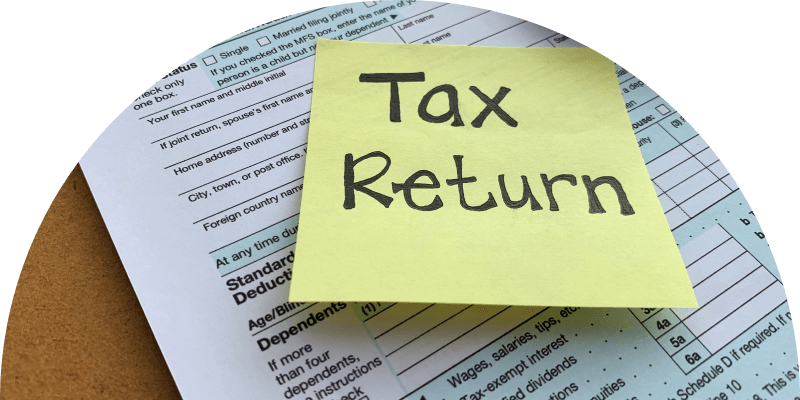- Find an office
-
File Your Taxes
 Find a Location
Find a Location -
Resolve Tax Issues
 Resolve Tax Issues
Resolve Tax IssuesResolve Tax Issues
-
Tax Resources
 See all Tax Help
See all Tax HelpTax Tools
Tax Tips & Resources
- Refund Advance
- Hiring Local Jobs!
- Tax Services
- Promotions & Coupons
- Where's My Refund
- Careers
- Search
- Contact Us
- Feedback
-
 Log in | Sign up
Log in | Sign up

JH Accounts
|
|
Oh no! We may not fully support the browser or device software you are using ! To experience our site in the best way possible, please update your browser or device software, or move over to another browser. |
FILING YOUR TAXES
What you need to know for the 2026 tax season

Every year, the Internal Revenue Service (IRS) makes changes to the tax code. We are here to help you be ready for when you file your 2025 taxes. Read more to find out about the difference between tax season and tax year, how the standard deduction has changed, what the tax bracket changes are, an overview of tax deductions and credits, and more.
Key takeaways
- The deadline for filing federal income tax for 2025 is Monday, April 15, 2026.
- If you’re wondering when you can file your 2025 tax return, the IRS generally begins accepting tax returns in late January each year.
- You can still prepare to file your 2025 taxes early by gathering the information you need—such as your W-2 and other important tax documents.
- You may also want to consider if there were any big lifestyle changes for you or your family this year.
- Jackson Hewitt’s Tax Pros can help you get ready for tax season.
Tax season vs. tax year
Often people ask what the difference is between tax season and tax year. They aren’t the same thing. The tax year is the actual year in the upper right corner of your tax return, for when you earn income, make charitable contributions, work side gigs, and so on. The tax season is when you file, report, and pay any taxes owed from the prior year, and get your refund. So, during the 2026 tax season, you file taxes for the 2025 tax year.
Tax bracket changes in 2025
The 2025 tax year—the return you'll file in 2026—will have the same seven federal income tax brackets as the prior year: 10%, 12%, 22%, 24%, 32%, 35%, and 37%, which are the percentages used to determine tax by taxable income level . Your filing status and taxable income, including wages, will determine the bracket you're in. Tax brackets are part of a progressive tax system, meaning each new bracket builds on the previous one. For example, if a single taxpayer has a taxable income in the 22% tax bracket, it’s not all taxed at that rate. Instead, the first $11,925 is taxed at 10%, from $11,925 to $48,475 at 12%, and the remaining income after $48,475 at 22%. The amounts for each tax bracket are added together for the full income tax amount.
Standard deduction increase in 2025
As you begin to think about filing your 2025 taxes, you may also be thinking about your tax deductions. Tax deductions, often called tax write-offs, can help decrease your taxable income. Less taxable income translates into a smaller tax bill—or a larger refund for you and your family.
The standard deduction increases annually for all filing statuses. This means you can write off more to help make up for inflation. For married couples filing jointly for tax year 2025, for example, it rises to $30,000, up $800 from the prior year.
For single taxpayers and married individuals filing separately, the standard deduction rises to $15,000 for 2025, up $400. And for heads of household, the standard deduction will be $22,500, up $600 from the amount for tax year 2024.
Standard deduction amounts for 2025 taxes
|
Filing Status |
Standard Deduction 2025 |
|
Single, or Married Filing Separately |
$15,000 |
|
Married Filing Jointly & Surviving Spouses |
$30,000 |
|
Head of Household |
$22,500 |
You can also choose to itemize your deductions, rather than taking the standard deduction. If your total itemized deductions exceed the amounts above, you may consider itemizing. If you have less than the standard deduction to write off, stick with that. You’ll also want to begin thinking about tax credits for which you may qualify. A Jackson Hewitt Tax Pro can help you decide what is best for your specific situation.
Tax deductions to consider for tax season 2026
If you want to think about itemizing your deductions, the IRS also provides a list of deductions, adjustments to income, and the requirements for claiming them on Form 1040, Schedule 1.
Some of these include:
- Educator expenses;
- Health savings accounts (HSAs);
- Several self-employment expenses, such as retirement plan contributions, health insurance premiums, and half the self-employment tax as reported on Schedule SE;
- Savings withdrawal penalty amounts;
- Student loan interest;
- The traditional IRA deduction;
- Alimony paid for divorce decrees before 2019;
- Moving expenses for certain members of the military; and
- Costs incurred by military reservists, performing artists, and fee-based government officials.
Are there any special deductions if you own a business in 2025?
It’s important to note that self-employed workers, small-business owners and gig workers might be eligible for a deduction of 20% of eligible qualified business income before taxes. This is called the Qualified Business Income Deduction (QBID).
The QBID is one of the most common tax write-offs for self-employed workers. For tax year 2025, you can take this deduction if your taxable income falls below $197,300 for individuals, or $394,600 for joint returns and certain taxpayers with higher business income.
QBI does not include wages earned as an employee and business-generated capital gains, interest, and dividend income. You can work with your Tax Pro to see what other deductions may apply for your business.
In addition to the QBID, there are many deductions available to reduce the net profit for a business. Reducing net profit lowers income tax and the taxes self-employed taxpayers must pay. See below for a list of deductions.
Tax credits for 2025
Tax credits give you a dollar-for-dollar reduction for tax you owe. Below are some examples of popular tax credits, but your Jackson Hewitt Tax Pro can work with you on which ones will work for you and your family.
Earned Income Tax Credit (EITC)
For 2025, the EITC can potentially give you between $649 and $8,046, depending on how many qualifying children you have. This is something to explore if your adjusted gross income (AGI) is below $69,000. AGI is gross income minus certain adjustments—such as one half of the self-employment taxes and traditional IRA contributions. Gross income refers to the total income that includes wages, net profit from self-employment, interest and dividends, retirement income, etc. Your AGI is extremely important because many deductions and credits are determined with AGI.
Child Tax Credit
You may be able to claim the full Child Tax Credit if your modified adjusted gross income (MAGI) is under $200,000—or under $400,000 if you and your spouse file a joint return. If your MAGI is greater than $200,000 ($400,000), the credit is reduced by $50 for each $1,000 over the threshold amount.
Lifetime Learning Credit
If you paid expenses related to college, graduate, or vocational school, you may claim the Lifetime Learning Credit, one of the most popular tax breaks. This is a non-refundable credit of up to $2,000 (per return) of qualified tuition, fees, and expenses you paid for yourself, spouse, or a dependent. A non-refundable tax credit means you can only use the credit to reduce your taxes, and any remaining amount can’t be added to your refund. There are more childcare, educational and other tax credits that you may want to explore with your Tax Pro.
What documents do I need to file my 2025 taxes?
Before you begin filing your taxes, gather all the documentation you’ll need to complete your return.
Along with copies of previous tax returns and Social Security numbers and other taxpayer identification numbers for those on your tax return, additional documentation and receipts you’ll need to file your 2025 taxes include:
- Social Security benefits;
- Unemployment compensation;
- Form W-2 for annual wages;
- Form 1099-INT for any interest income;
- Form 1099-NEC and 1099-K for self-employment including gig income;
- Form 1099-G for certain government payments such as unemployment compensation and state or local income tax refunds;
- Form 1099-DIV for dividends and capital gains distributions received from stocks, bonds, and mutual funds;
- Form 1099-R for distributions from pensions, annuities, retirement or profit-sharing plans, IRAs, and other types of retirement plans; and
- Form 1095-A (Health insurance Marketplace Statement) prepaid amounts for your health insurance purchased through your state’s marketplace;
- Income and expense receipts for your small business or farm;
- Income and expense receipts from rental property and royalties; and Schedule
- K-1s from trusts, estates, subchapter S corporations, and partnerships, if applicable.
Not sure what documents you need to bring? A Tax Pro can help you figure out which forms apply to you or you can use our document checklist. Rest assured that many forms, such as W-2 forms, will be sent to you automatically by January 31.
Benefits of filing 2025 taxes as soon as possible
As mentioned above, you have until April 15, 2026 to meet the federal taxes deadline, but there are many benefits to filing earlier. Consider the following strategies and their advantages:
- Direct deposit could shorten the time it takes to receive your refund. Time is money, and the earlier you get your money, the sooner you can put it to use. Or you can save the money or put it toward something you and your family want or need. File your tax return electronically to get the fastest tax refund and request direct deposit to your bank account. This can shave weeks off the time it can take to receive a tax refund check in the mail.
- If you work early with a Tax Pro to file your taxes, you’re more likely to get the appointment you want. The closer it gets to the tax deadline, the more quickly appointments get filled. Schedule your appointment as early as you can to ensure you’re able to meet with a Tax Pro when you want.
- For divorced or separated taxpayers, the IRS recognizes the physical custodial parent as the one eligible to claim the dependent. For the custodial parent, it’s important to file early to make sure that you claim your dependents.
Although April 15, 2026 may seem a long way off, it always pays to be prepared and to make sure that you are keeping track of any documents or big changes that may occur year-to-year. Find a Jackson Hewitt Tax Pro near you today.
Read more articles from Jackson Hewitt
Get money today!
Reserve your spot to easily apply for a Tax Refund Advance loan.

Starting at $49 to file fed taxes!
100% taxes done right. 100% your max refund. Terms apply.
Because trust, guarantees, convenience & money all matter

-
TRUSTED GUARANTEES.
Be 100% certain about your money & your taxes, year after year.
-
NATIONAL PRESENCE. LOCAL HEART.
We’re in your neighborhood & inside your favorite Walmart store.
-
40+ YEARS. 65+ MILLION RETURNS.
The kind of trusted expertise that comes with a lifetime of experience.





